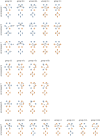The ensemble of gene regulatory networks at mutation-selection balance
- PMID: 36596452
- PMCID: PMC9810427
- DOI: 10.1098/rsif.2022.0075
The ensemble of gene regulatory networks at mutation-selection balance
Abstract
The evolution of diverse phenotypes both involves and is constrained by molecular interaction networks. When these networks influence patterns of expression, we refer to them as gene regulatory networks (GRNs). Here, we develop a model of GRN evolution analogous to work from quasi-species theory, which is itself essentially the mutation-selection balance model from classical population genetics extended to multiple loci. With this GRN model, we prove that-across a broad spectrum of selection pressures-the dynamics converge to a stationary distribution over GRNs. Next, we show from first principles how the frequency of GRNs at equilibrium is related to the topology of the genotype network, in particular, via a specific network centrality measure termed the eigenvector centrality. Finally, we determine the structural characteristics of GRNs that are favoured in response to a range of selective environments and mutational constraints. Our work connects GRN evolution to quasi-species theory-and thus to classical populations genetics-providing a mechanistic explanation for the observed distribution of GRNs evolving in response to various evolutionary forces, and shows how complex fitness landscapes can emerge from simple evolutionary rules.
Keywords: gene regulatory networks; mutation–selection balance; neutral network; quasi-species theory.
Figures





Similar articles
-
Evolution of gene regulatory networks by fluctuating selection and intrinsic constraints.PLoS Comput Biol. 2010 Aug 5;6(8):e1000873. doi: 10.1371/journal.pcbi.1000873. PLoS Comput Biol. 2010. PMID: 20700492 Free PMC article.
-
Evolution of gene regulatory networks by means of selection and random genetic drift.PeerJ. 2024 Aug 28;12:e17918. doi: 10.7717/peerj.17918. eCollection 2024. PeerJ. 2024. PMID: 39221262 Free PMC article.
-
Stochasticity versus determinism: consequences for realistic gene regulatory network modelling and evolution.J Mol Evol. 2010 Feb;70(2):215-31. doi: 10.1007/s00239-010-9323-5. Epub 2010 Feb 12. J Mol Evol. 2010. PMID: 20151115
-
Patterns of selection across gene regulatory networks.Semin Cell Dev Biol. 2023 Aug;145:60-67. doi: 10.1016/j.semcdb.2022.03.029. Epub 2022 Apr 23. Semin Cell Dev Biol. 2023. PMID: 35474149 Review.
-
Understanding cancer from a biophysical, developmental and systems biology perspective using the landscapes-attractor model.Biosystems. 2025 Jan;247:105376. doi: 10.1016/j.biosystems.2024.105376. Epub 2024 Nov 22. Biosystems. 2025. PMID: 39581534 Review.
Cited by
-
A Family of Fitness Landscapes Modeled through Gene Regulatory Networks.Entropy (Basel). 2022 Apr 29;24(5):622. doi: 10.3390/e24050622. Entropy (Basel). 2022. PMID: 35626507 Free PMC article.
References
Publication types
MeSH terms
Associated data
LinkOut - more resources
Full Text Sources
Miscellaneous

